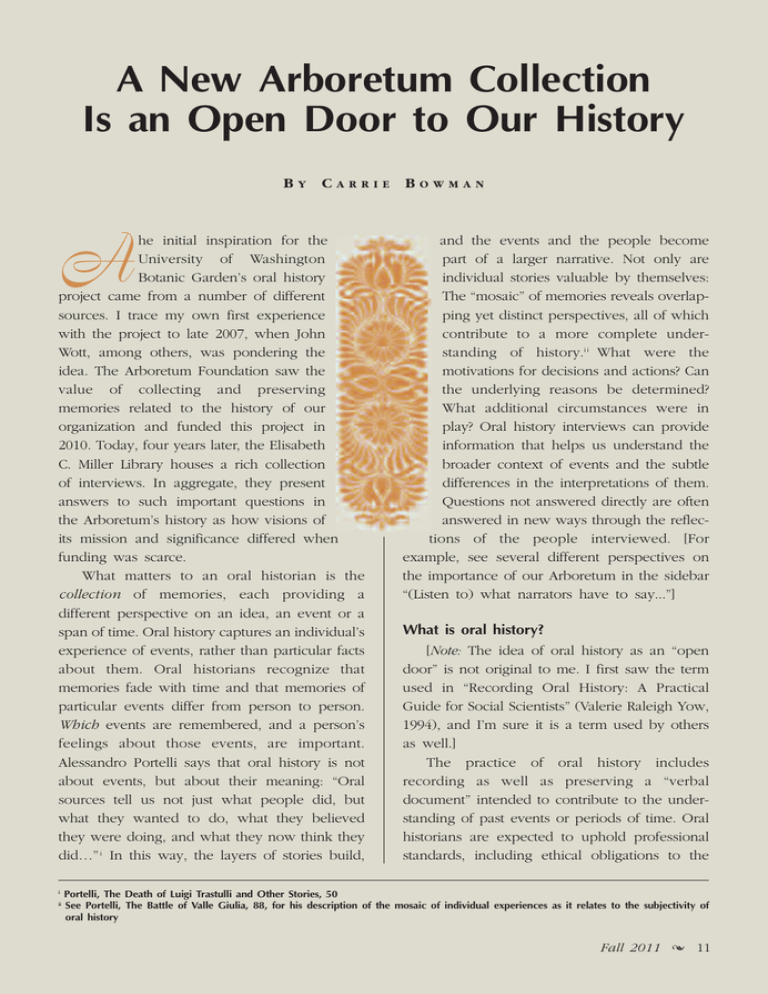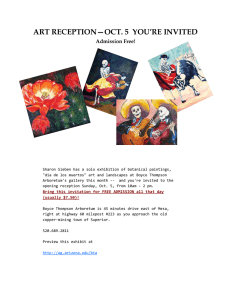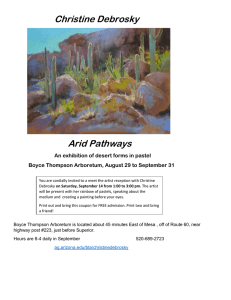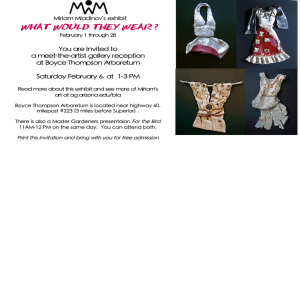A
advertisement

A New Arboretum Collection Is an Open Door to Our History BY A CARRIE he initial inspiration for the University of Washington Botanic Garden’s oral history project came from a number of different sources. I trace my own first experience with the project to late 2007, when John Wott, among others, was pondering the idea. The Arboretum Foundation saw the value of collecting and preserving memories related to the history of our organization and funded this project in 2010. Today, four years later, the Elisabeth C. Miller Library houses a rich collection of interviews. In aggregate, they present answers to such important questions in the Arboretum’s history as how visions of its mission and significance differed when funding was scarce. What matters to an oral historian is the collection of memories, each providing a different perspective on an idea, an event or a span of time. Oral history captures an individual’s experience of events, rather than particular facts about them. Oral historians recognize that memories fade with time and that memories of particular events differ from person to person. Which events are remembered, and a person’s feelings about those events, are important. Alessandro Portelli says that oral history is not about events, but about their meaning: “Oral sources tell us not just what people did, but what they wanted to do, what they believed they were doing, and what they now think they did…” i In this way, the layers of stories build, i ii BOWMAN and the events and the people become part of a larger narrative. Not only are individual stories valuable by themselves: The “mosaic” of memories reveals overlapping yet distinct perspectives, all of which contribute to a more complete understanding of history.i i What were the motivations for decisions and actions? Can the underlying reasons be determined? What additional circumstances were in play? Oral history interviews can provide information that helps us understand the broader context of events and the subtle differences in the interpretations of them. Questions not answered directly are often answered in new ways through the reflections of the people interviewed. [For example, see several different perspectives on the importance of our Arboretum in the sidebar “(Listen to) what narrators have to say...”] What is oral history? [Note: The idea of oral history as an “open door” is not original to me. I first saw the term used in “Recording Oral History: A Practical Guide for Social Scientists” (Valerie Raleigh Yow, 1994), and I’m sure it is a term used by others as well.] The practice of oral history includes recording as well as preserving a “verbal document” intended to contribute to the understanding of past events or periods of time. Oral historians are expected to uphold professional standards, including ethical obligations to the Portelli, The Death of Luigi Trastulli and Other Stories, 50 See Portelli, The Battle of Valle Giulia, 88, for his description of the mosaic of individual experiences as it relates to the subjectivity of oral history Fall 2011 11 narrators (the people interviewed).iii Narrators are given the opportunity to restrict access to all or part of their interviews. Interviewers recognize that questions, as well as the way in which they are framed, influence responses. In fact, the very presence of an interviewer can shape a narrator’s memory of an event. With this in mind, an oral historian strives to open a door and then allow a narrator to explore and reflect. Narrators are free to attribute meaning to events and to introduce topics at will. Of course, a project must maintain focus, and the questions asked each narrator are relevant to his or her experience, but the desire to capture personal interpretations of events overrides a desire for answers to specific questions. Finally, oral historians are committed to preserving a body of work—the collection of interviews—by securing the original interviews (that are saved in digital form, in our case), by creating back-up copies, and by offering additional unedited copies for public use. The public collection of interviews at the Miller Library is available to everyone. The narrators have transferred copyright of their interviews to the University of Washington so that permission is not required each time someone wants to listen to an interview. Listeners can incorporate all or part of an interview into original work. The Miller Library, as the institution responsible for storing the interviews and providing access to them, monitors their use. The interviews are not available for commercial purposes, and copies are not available for distribution. The Library encourages people to adopt a critical approach to interpretation. Dr. Lorraine McConaghy, Historian at Seattle’s Museum of History & Industry, recommends the rule of three: Consult three primary sources before drawing conclusions or creating an argument using material from an oral history interview. Oral history interviews tell only part of a story. Stacy Ericson of the Idaho Oral History Center notes that “…if we then integrate the oral source with other kinds of historical research, we can arrive at an account of past events which is human in its approach without sacrificing necessary accuracy.”iv Our project Shelly Leavens spent the past nine months interviewing people (See narrator inserts “The Narrators” and “(Listen to) What the Narrators Have to Say.”). We sought narrators with longterm associations with the Washington Park Arboretum, the Arboretum Foundation and/or the Center for Urban Horticulture. We consulted many people, looking for narrators who fulfilled multiple roles within these organizations, as well as narrators from outside them, so that we could document a variety of perspectives about a past rapidly disappearing from our living memories. The narrative created by our compilation— our collection—is an open door to our history. The intent of this phase of the project was to For a complete discussion of principles for oral history and best practices in the United States, see http://www.oralhistory.org/do-oralhistory/principles-and-practices/ iv Ericson, v iii THE NARRATORS Dick Brown Barbara Carman Dale Cole Nancy DavidsonShort Marion Docter Sylvia Duryee Paul Gibson Donald Graham, Jr. Jean Haigh Barbara Harris Donald Harris 12 Washington Park Arboretum Bulletin Grant Jones Art Kruckeberg Elizabeth Moses Vincil Dean Powell (not yet scheduled) Lyn Sauter Carol Simons Shelia Taft Harold Tukey Jean Witt John Wott collect a variety of interviews, index them so that people can determine what was discussed, and organize them so that materials relevant to each interview are stored in one place. Research materials, field notes, indexes and narrator data sheets are all included with the interviews. We encourage people with any interest, whether general or for a specific purpose, to consult the indexes and listen to the interviews. Each narrator gives meaning to his or her experiences; anyone who listens to the interviews can offer their own interpretation of the compiled memories. Though publications, displays and walking tours are typical outcomes for oral history projects, online or other media productions are more and more common. (A few are listed at the end of this article.) We sincerely hope that with the addition of the interviews in our young oral history collec- tion, listeners can begin to understand the process through which the University of Washington Botanic Gardens has developed and evolved. If you would like to learn more about our oral history project, plan to visit the Miller Library, which will present a special display from mid-October until November 20. All are also welcome to attend an open house and reception on November 1 (5-7 p.m.) that will showcase the project and give people a chance to meet some of the narrators. Check the Miller Library Web site (millerlibrary.org) for details or call the library at (206)543–0415 for more information. Examples of online oral history projects British Library—Archival Sound Recordings http://sounds.bl.uk/ Broadcastr (beta)—What’s your story? http://beta.broadcastr.com/ (continues on next page) (LISTEN TO) WHAT THE NARRATORS HAVE TO SAY… OF WHAT VALUE IS OUR ARBORETUM? Jean Witt—…The interesting thing about the Arboretum is that it’s very well known internationally and underappreciated at home and this pattern has continued, but…even so, its situation is…lots better locally than it used to be…it makes it difficult…in some ways that it is an open park and because it gets uses that are not compatible…for instance, they have trouble with theft: a clump of double Trillium ovatum was swiped… Jean Haigh—…Well, I really wanted to see groups of school children going through with some Arboretum person that was knowledgeable as well as their classroom teacher, so that was what I thought should happen, but it didn’t happen during the time I was still teaching, I didn’t see that… Elizabeth Moses—…The Arboretum is more of a park…and it should be open as parks are, but it would be nice if we could charge…a reasonable fee…because we’re so bare bones, we’re so way under the standard of other arboreta across the country in the number of acres each person is responsible for taking care of…the Arboretum is an important resource, it’s not just a piece of Volunteer Park or Seward Park, it’s a study group and it’s a very important scientific collection of plants… Paul Gibson—…So you’ve got this institution which is unusual, it’s some sort of hybrid. It’s a museum of…woody plants, in a public park, and those are not the same thing…but they each have their constituency…the weight between these two uses, the constituency which is my constituency, the general park user constituency, is not represented nearly as well…as is the arboretum function and that constituency… Art Kruckeberg—…Well, I think access to an arboretum shouldn’t be through a gate. I think it should be through good intentions and freedom…the notion of a fence plus an admission fee was part of the projection, which we also rejected…I think you’ve picked the three elements that made it an invaluable city resource: people use it as a park, people use it as a learning device, and people use it as something to preserve. Fall 2011 13 Save the Date! Dec 11 & 12 Gifts & Greens Galore Saturday 12/11: 10am - 2pm Sunday 12/12: 10am - 2pm Graham Visitors Center Gifts, wreaths, & greens, live music, holiday refreshments, & more Save your Clippings! We will be accepting donations of fresh-cut greens from Monday, December 6, through Friday, December 10, between the hours of 10am and 3pm. See the website for more details and our wish list! www.arboretumfoundation.org 206-325-4510 14 Washington Park Arboretum Bulletin Center for Wooden Boats, Seattle—Oral Histories http://cwb.org/south-lake-union/online-museum/oral-histories http://theemptyroom.org/thesis/hotc_map.html http://cwb.org/south-lake-union/online-museum/oral-histories/history-craft-interviews-shipwrights-lake-union Denshō—The Japanese American Legacy Project http://www.densho.org/ Imperial War Museum—IWM Collections Search http://www.iwmcollections.org.uk/qrySound.asp Laurelhurst Beach Club Sailing Fleet, Seattle http://lbcsailing.com/ New York City Taxi Driver Oral History Project http://nyctaxisoralhistory.com/project/ Project Jukebox—Alaska & Polar Regions Collections / Elmer E. Rasmuson & BioSciences Libraries (University of Alaska Fairbanks) http://jukebox.uaf.edu/site/ University of Oxford—Diabetes Stories http://www.diabetes-stories.com/index.asp Woices—World Voices—Listen to the People! http://woices.com/ REFERENCES Ericson, Stacy. “A Field Notebook for Oral History.” 5th ed. (revised by Kathleen Rubinow Hodges and Ellen Haffner). Boise, ID: Idaho Oral History Center, Idaho State Historical Society, 2009. Oral History Association. “Principles for Oral History and Best Practices for Oral History.” Oral History Association: Principles and Best Practices. October 2009. Accessed June 2011. http://www.oralhistory.org/do-oral-history/principlesand-practices/ Portelli, Alessandro. “The Death of Luigi Trastulli and Other Stories: Form and Meaning in Oral History.” Albany, NY: State University of New York Press, 1991. Portelli, Alessandro. “The Battle of Valle Giulia: Oral History and the Art of Dialogue.” Madison, WI: The University of Wisconsin Press, 1997. Yow, Valerie Raleigh. “Recording Oral History: A Practical Guide for Social Scientists.” 1st ed. Thousand Oaks, CA: Sage Publications, Inc., 1994. C ARRIE B OWMAN has worked at the Elisabeth C. Miller since 2006. She also is a teen services librarian in the King County Library System. In one of her former lives she worked for 14 years as a gardener for Seattle Public Libraries. In another, she taught middle and high school biology and math. S HELLY L EAVENS , primary interviewer on this project, has been conducting oral history based on research since 2004. A recent graduate of the Museology Graduate Program at the University of Washington, she now teaches in the U of W Museum Studies Certificate Program and contracts with various organizations.


